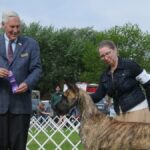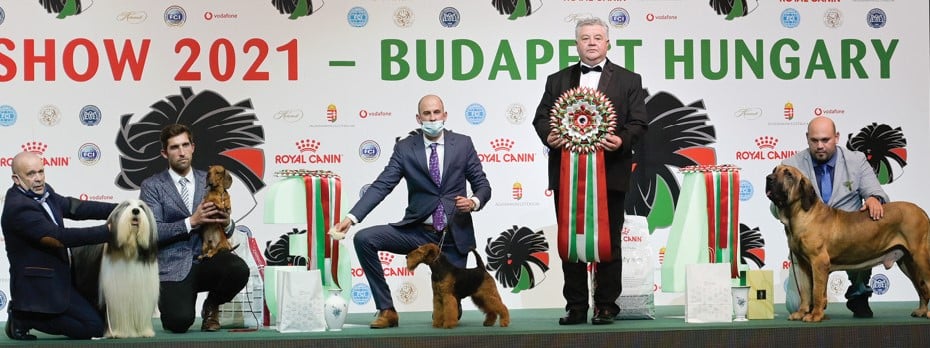FCI European Dog Show 2021
COVID, COVID, COVID… it causes lots of difficulties, especially for organizing big events. A variant of it, Omicron, discovered only a few weeks before the show, was announced as a very aggressive mutation, mainly in spreading the virus. The Budapest European Dog Show, originally planned for May 2021, had already been postponed and was again facing a new threat! Would there be another postponement coming up? Fortunately, new restrictions had not yet been issued, except for a few countries, so Hungary welcomed visitors on the condition that they had a COVID-safe passport and were wearing a mask. This was imperative.
I was worried what the impact of the new date would be on the number of entries. The Budapest Grand Prix Winner Show and the FCI European Dog Show were scheduled from December 28 till December 31, 2021! Wasn’t this very risky, right after Christmas till New Year’s Eve? It proved not to be, in the end. For the Winner, 4,151 dogs were entered, and for the European, as many as 10,801 dogs were on schedule. Of course, we will never know what the result would have been if there was no COVID to take into account. Sure, a lot of people would hesitate to spend all that money to make the trip and book a hotel with the possibility in mind that the show could be canceled in the end, and others probably would prefer not to travel that far, risking ice and snow on the roads or missing the best winter days with family. But, on the other hand, many would also see it as an opportunity to combine a big dog show with a winter city trip to Budapest in Christmas decoration. Anyway, almost 11,000 dogs is far from bad. Of course, the number of entries for the European, the Winner, and all the Specialty shows together will probably outnumber 20,000. However, I don’t take this into account, as often it is the very same dogs that are entered for these different sub-shows.
The Winner Show was good for 4,151 dogs and offered an extra opportunity to finish the Hungarian Champion title. This show lasted very long and finished only around 9pm. This was not a good start for those who had to show their dog the next day and still had to wash and groom them. Most dogs were entered for the European Dog Show, and they came from no fewer than 58 different countries as far as Brazil, New Zealand, Canada, Peru, Japan, and Argentina. The majority, however, were from countries in Europe: 3,153 dogs were Hungarian dogs; 927 came from Poland; 986 from Italy; and 785 from Russia. (This was a lot more than for the World Show in Brno where there were only 156 Russian entries!) Czechia and Slovakia had 1,002 entries; Ukraine, 438; Serbia, 417; and Romania, 378. Finland had 260 dogs entered; Spain, 172; and France, 190. There was a lockdown in the Netherlands and this might be the explanation for why only 65 dogs were entered. This was probably the case for many other countries too. The United Kingdom was good for 33 dogs, Mexico for 6, Australia for 4, and the United States for 11!
Entering a dog is one thing, showing a dog is another, especially during the last two years. COVID seems always just around the corner with new attacks and new measures to fight it. It is clear, anyway, after questioning several judges, that there was a significant increase of absent dogs with 10 to 20 percent. This is a guess as more exact numbers were not to be found because the results were only limited to the dogs that won a title like BOB, BOS, Junior Winner, etc., and not all participating dogs. The pandemic has also caused continuous changes to the judges list, and this can also make exhibitors hesitate to enter their dog until the very last moment—or not at all. Yes, we must admit that organizing a show of this size is quite a perilous and risky business, but in the end, we had another well-organized, big European Dog Show… another good job by the Hungarian Kennel Club.
The Hungarian Kennel Club already has a long tradition of organizing events of this size. In 2008, they organized the FCI European Dog Show for the first time, and in 2013 they were granted the honor to hold the FCI World Dog Show. Each time it has happened at the very same location, Hungexpo, a big complex of event halls on the outskirts of Budapest. It is a very nice area for a show of this size, with plenty of parking around. The two main halls are very huge and the hall where most of the rings were located was very bright inside. Everything inside and outside gave a clean impression all day long. Compared to previous editions, the number of trade stands, in and outside the halls, was very limited and decreased from largely over 100 for the 2013 Show to about only 20, plus some small stands outside, mainly providing food and local items for sale. In mid-winter, having a trade stand is risky. It is not cheap to hire a place and to know that if the weather is bad there will be hardly any visitors. With all the “ifs” in mind, it could easily result in a serious loss. Fortunately, the weather was dry, cold but fine, though nobody was able to predict this weeks before the event when the booking had to be made. Royal Canin was the main sponsor and was dominantly present in every hall. The rings were of average size, and in between the rings the space was sometimes very crowded. With COVID in mind, this was sometimes even somewhat frightening. Fortunately, contrary to the World Dog Show of Brno, the wearing of masks was very well followed. Only from time to time were there some clusters of people who did not follow the rules correctly. In general, however, it was okay. Whether this had to do with the organization, the discipline of the exhibitors, or the fear of the new Omicron wave was hard to tell.
A minor point was the catalog. Catalogs are no longer given to every exhibitor, as they can now consult a digital version online. If you want a printed catalog, you have to order it and pay extra for it. The catalog itself was not very easy to use. Looking for a breed was very confusing, as there was no alphabetical breed list. If you were looking for a certain breed and where to find it, you had to look at the list of judges, which meant that you had to look at all of them in detail, unless it was a judge listed on top. And to make it more complicated, the judges were not ordered alphabetically but according to the ring number! Furthermore, under their names, the breeds were listed in Hungarian on the left and in English on the right, but only if there was a different English translation for the breed name. When I was looking for the ring of the Hovawarts, assisted by someone to help me, it took us quite a long time before we understood the system. We had ony been looking on the right side of the page, being of the opinion that every breed was mentioned in Hungarian AND in English. But Hovawart is the same in both languages, and thus, mentioned only on the left. So, we overlooked it several times. And as if that was not enough, there was no indication at all where the breed could be found in the catalog! There was not a single reference to the entry number or page. The first list was useless, in fact, as I was forced to turn page after page until I found the page with the breed I was looking for, and the separation of the breeds was not very clearly defined—only in a bold and slightly larger font—without clear separations with spaces or lines. It also surprised me that the ring stewards worked the old way, writing down everything on paper and not using tablets. This is probably the reason why we can only find the main results online, the CACIB’s, ResCACIB’s, Junior European Champions, etc. It would probably cause too much trouble to fill out everything online, and this is also why I can only estimate the rate of absentees by questioning the judges. The main ring results were only consultable in a PDF file, with no reference to the name of the judge and no ring number of the dog if you wanted to find out more about the breed judge, the breeder, or the ancestors of the dog. It caused me a lot of time to compile the list of results. It is surprising that even nowadays so many young people do not understand, let alone speak, proper English. I came by public transport to the show grounds every day, and especially on the first day, I was lost in the area. Not only was I given wrong directions, I was also surprised that nobody from the neighborhood seemed to know that there was a very big and most international dog show in their town. I wonder what impact this had on the number of visitors.
The main ring was situated in Hall G, the second largest one. Like in Brno, there were only very few rings inside, and they were mainly reserved for breed clubs, specialties, and Junior Handling. The company P1 Dog Shows was hired to organize the main ring and everything around it. This is a very specialized crew from the Czech Republic that consists of a professional crew that arranges the show from A to Z. They have not only a professional livestream team, they also own a digital background, including a podium with large panels for showing the Group that is on turn in the ring at that moment, the name of the judge, and the flag of the judge’s nationality. They also have their own ring stewards, nicely dressed in gala outfits, who are wirelessly in contact with the director via earphones. They also serve as security when needed, and watch over the good order in the main ring. They guide the judge and take care that all dogs are presented in the very same way. The whole show is professionally presented by a lovely lady in a gala dress, translating the comments of her Hungarian presenter into English. It was not the first time that I saw this team working and it seems that they get better, and more equipped, every time. They’ve made the new standard in the world of dog shows. We will probably see them again in Paris. Unfortunately, the setup of the main ring was not ideal for us reporters and photographers. When the dogs entered the main ring, they entered on our side and this prevented us from taking good movement shots as they were too close to us.
Hungarians are a very proud people, and this showed off in the main ring where long speeches were held with much protocol. Everybody can tolerate a speech, even two, but there were too many and they usually took too long because they had to be translated each time. It would have been better to insert more entertainment. (There are enough canine disciplines that qualify for this.) Besides, there were a lot of categories to be judged too, like Minor Puppies and Puppies, World Cup Hungarian Breeds Junior BIS, World Cup of Hungarian Breeds BIS, Best Hungarian Shepherd Dog, Best Hungarian Hunting Dog, Interra Junior BIS, Interra BIS, etc. Fortunately, as every item of the program was strictly timed, the three days of the European Show ended well on time, even the last day, New Year’s Eve. But of course, a dog show day is usually already a very long day, and exhibitors want to go home on time, often awaiting a very long journey home. Visitors need to go home for dinner, especially if they have children, and this is shown when you look at the stairs that get more empty by the minute once 6 o’clock has passed. My advice is, don’t overdo things. Mix with more entertainment, and schedule less in a more acceptable timetable, where 6 o’clock is a perfect hour to finish things.
A minimum of 156 judges were scheduled from 37 different countries. I have no idea if different judges were invited for the Winner and the Specialties, as usually the judges for the European also judge different breeds in the Specialties. Again, it is hard to tell how many of the scheduled judges had canceled at the last moment and had to be replaced. Of course, 156 is a lot and “only” 47 of them were Hungarian judges of whom many were specialists in Hungarian breeds. There were also a lot more “uncommon names” and this probably meant that they were not recruited from the “regular” legion. This is a good thing because exhibitors don’t like to always see the very same judges all over again. This does not say anything about their quality, of course, but for events like this, exhibitors like to see more specialists. Sure, as events like this usually coincide with FCI meetings that the Presidents of Kennel Clubs need to attend, and as many of these often used to be Group or all-round judges, it is cheaper to plan those judges also for the show. However, care must be taken that this does not end into a fixed carrousel. Use them moderately, I would say, because an all-rounder’s vision can be more valuable than the vision of a “breed-blind” specialist judge, and a specialist judge is needed to keep the breeds as close as possible to the standard. This should be the logic in a dog show; a specialist doing the breed ring, and an all-rounder judging the finals. I noticed too that although only a few judges had more than 100 dogs to judge, none of the judges was overloaded. Breeds with big entries were spread nicely over different judges; for some breeds up to three judges were invited. Here is a small overview of the most popular breeds in the show. On Day 1, we enjoyed 196 French Bulldogs, 128 Boston Terriers, 130 Chihuahuas, 146 Whippets, 101 Weimaraners, 122 Beagles, 109 Dalmatians, and 69 Basset Hounds. On Day 2, we had 167 Dobermans, 108 Dogo Argentinos, 128 Great Danes, 210 Cane Corso, 130 Bernese Mountain Dogs, and 92 Central Asian Shepherd Dogs. In Group V, we found 150 Huskies, 91 Samoyeds, 77 Chow Chows, and 160 Pomeranians. In Group VIII, 228 Golden Retrievers, 166 Labradors, and 128 English Cockers took the crown. And on Day 3, in Group I, 129 Border Collies, 92 Rough Collies, 133 Welsh Corgie Pembrokes, and 102 Aussies were shown, 100 Jack Russells and 217 American Staffordshire Terriers in Group III, and 156 Standard, 170 Miniature, and 99 Kaninchen Dachshunds represented Group IV.
Mr. Korozs Andras, President of the Hungarian Kennel Club, was the judge with the supreme honor to pick the Best in Show. Four dogs out of the 10 Group winners had to be placed. I still wonder why the FCI Dog Show World clings so strongly to that strange habit to have four dogs to be placed. I do not know of any other competition where four winners are placed, it is always three or two. Best in Show went to the Bearded Collie from France, “Ovation de Chester,” a 3-year-old bitch, owned by Audrey Garcia and bred by Thierry Bernardi. She was judged by Mrs. Barbara Müller from Switzerland and won the Group under Mr. Péter Harsánvi from Hungary who replaced Mrs. Anna Albrigo from Italy for the task. In total, 44 were entered. Reserve BIS went surprisingly to the Miniature Smooth-Haired Dachshund, “Minidogland Take After Sun,” a Russian entry by Daria Churakova. This bitch was six years old and entered in the Champion Class. The breed was judged by German judge Mr. Istvan Csik who had made his choice out of 73 entries. Mr. Cesare Calcinati from Italy was the one who chose her to compete in the finals. The Welsh Terrier, “Monaline Unit,” was again a bitch, three years old and owned by Vladimir Pijunovic and Lea Bartos from Croatia. Mr. Csaba Denk from Hungary had 17 to judge. Mrs. Helen Tonkson from Estonia was the Group judge. On Place 4 we found a surprise, a Fila Brasileiro, a gentle and happy one, marvelously presented by his handler. Thirty were entered to be judged by Mr. Christian Stefanescu from Romania. “Pontos V Do Rincao Violento” was the name of this 5-year-old male, owned by Giulia Manzoni from Italy. Mr. Stefanescu was also the judge who chose him as the winner of Group II.
All circumstances taken into account, this was a very good show. A courageous and risky decision was made, but would the weather be okay? Would COVID/Omicron be a bummer? Would exhibitors want to come right before New Year’s Eve? All of these questions had unpredictable answers. But it was okay—it was even good—and the Hungarian Kennel Club deserved it! The New Year’s Eve party in the Expo halls after the show was not planned, though as I heard afterward it seemed to be great. But for more details about that, you’ll need to ask the attendees. I was glad to leave the next day to meet my family.
Article and Photos by Karl Donvil
Miracle Mary Van Grunsven
Fab Point Alto Douro Fortuna
Mila Grandset Michelangelo David
Planet Waves Forever Young Daydream Believers
Sarabi Della Bassa Pavese
FCI European Dog Show 2021 | Budapest
Elamir Gypsy Power
Mansur Ebn Jaysito Von Haussman
Pontos V Do Rincao Violento
Echo Dechien Escuda Pour Garcon
Invidia Dios Mistero Di Amore
Kristari’s Mischief At Winter Melody
Samspring Carry On My Secret With Joy
Timanka`s Expensive Money
Galaksi All Rights Reserved
Lozung Absolute Legend Fernflower
Bottom Shaker The Greatest Picture
L`end Show Metti Surprise At Glare
Rollick`s Arc`teryx For Avalanche
Minidogland Take After Sun
Rollick`s Arc`teryx For Avalanche
Treis Pinheiros Eyesonl Yforyou
FCI European Dog Show 2021 | Budapest
FCI European Dog Show 2021 | Budapest
FCI European Dog Show 2021 | Budapest
FCI European Dog Show 2021 | Budapest
FCI European Dog Show 2021 | Budapest






















































